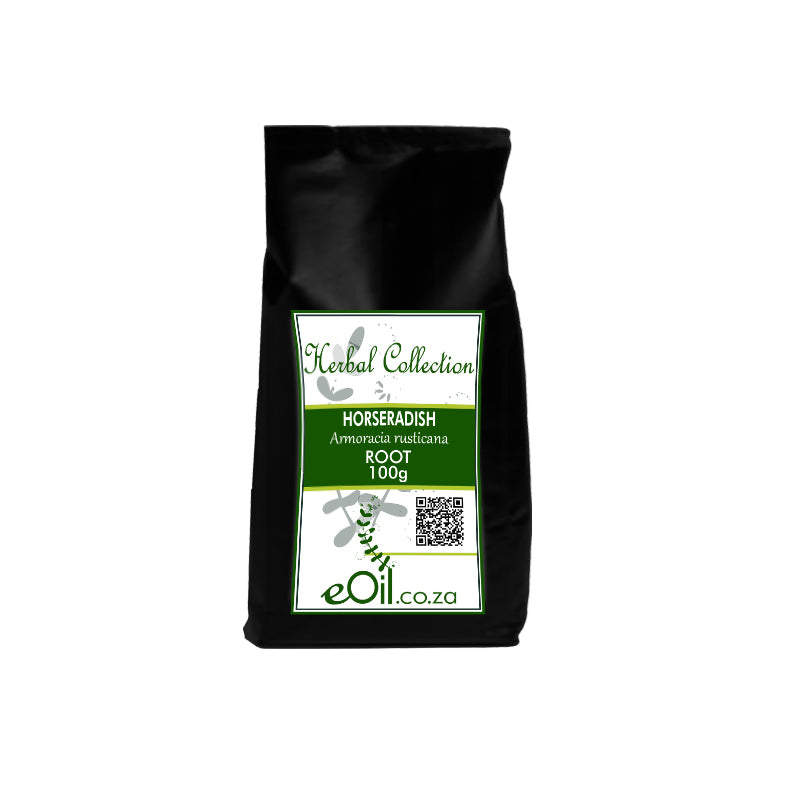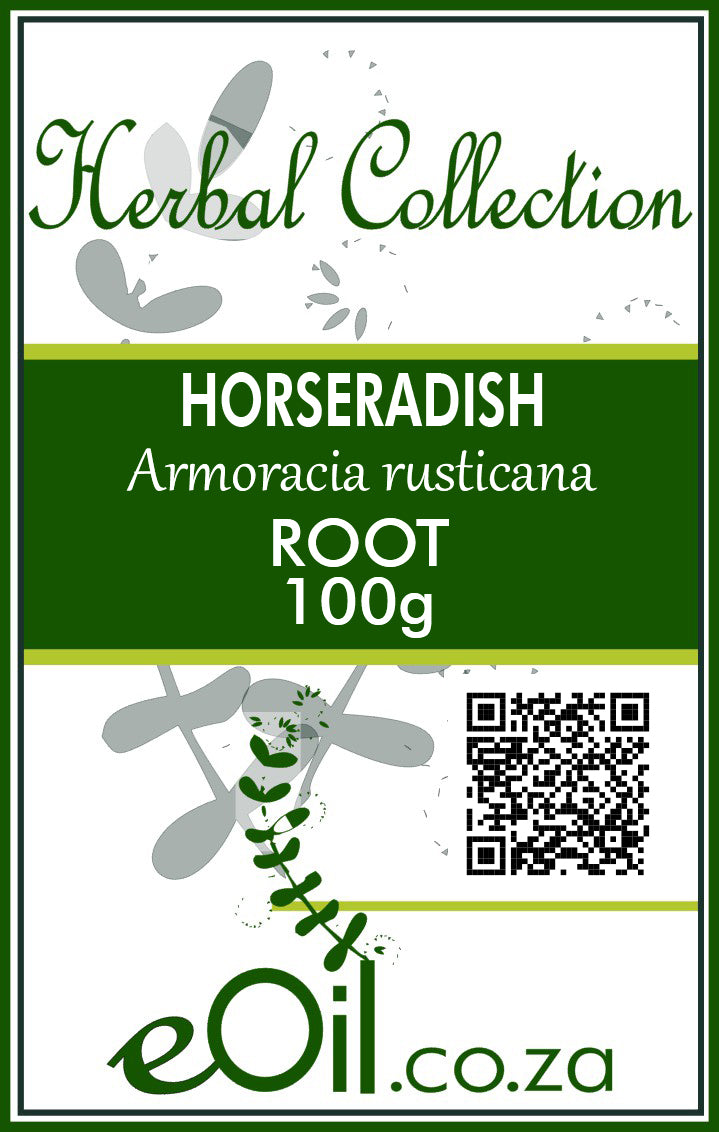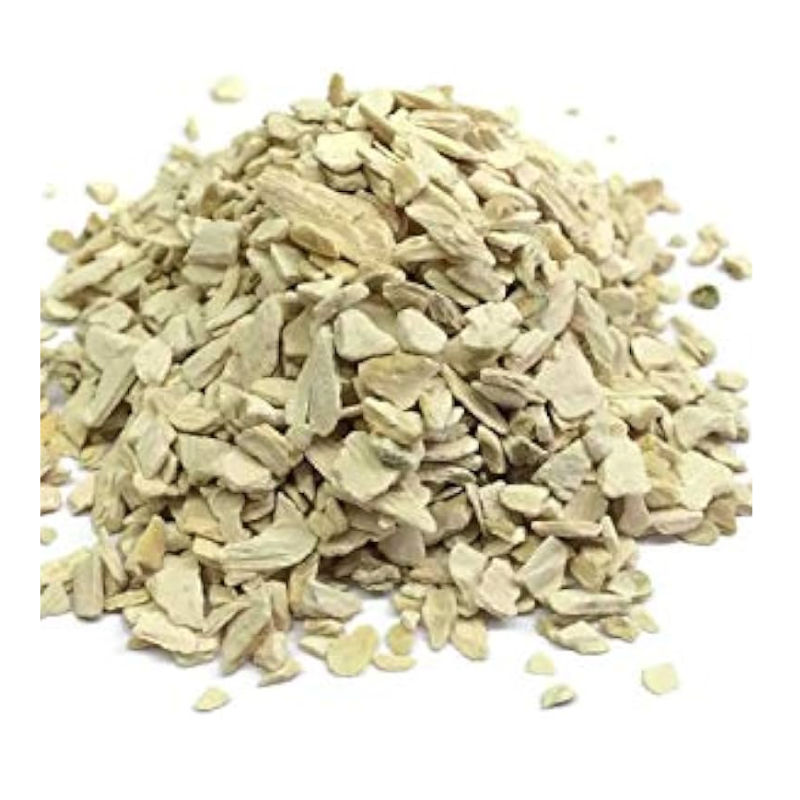Horseradish Root - Herbal Collection
Horseradish Root - Herbal Collection - 100 Gr is backordered and will ship as soon as it is back in stock.
Description
Description
Horseradish Root - Herbal Collection
TRADITIONALLY USED FOR
Horseradish Root Cuts (Armoracia rusticana) – Pure Dried Herb for Herbal Wellness & Culinary Use
Horseradish root cuts are the dried, chopped roots of Armoracia rusticana—valued both for culinary excitement and as a traditional botanical for respiratory, urinary, digestive, and immune health.
Key Benefits
- Traditional support for respiratory tract and sinus congestion, urinary tract health, immune defense
- Naturally pungent, spicy-tasting root: stimulates digestion and detoxification
- Antibacterial and diuretic properties—may help clear mucus, promote kidney/bladder function, and fight infections
- Rich in Vitamin C, potassium, and glucosinolates (mustard oil compounds)
- Keywords: horseradish root cuts, dried horseradish root tea, natural sinus support, immune botanical, digestive tonic, respiratory wellness herb
Instructions for Use / Posology
| Preparation | How to Use | Typical Dose & Frequency |
|---|---|---|
| Herbal Tea | Add 1–2 teaspoons dried root cuts to 1 cup water. | Steep 5–10 mins, strain; 1–2 cups per day |
| Culinary | Infuse in vinegar, grate into sauces, pickles | Use up to 10g daily. Adds spicy zest to food |
| Respiratory/Detox | As a tea or in “fire cider” blends with honey/vinegar | Use as desired in cycles of up to 12 weeks |
| Topical | Not advised for broken skin. Use cautiously due to strong irritant effect | For joint poultice, consult a professional |
COA, Safety & Storage
- Sourcing: Organically grown when possible, food-grade, minimal contaminants
- Analytical: Rich in isothiocyanates, vitamin C, potassium, analyzed for adulterants/heavy metals
- Storage: Store in a cool, dry, dark place to preserve potency
Who Should Avoid:
- Pregnant or lactating women: Strong compounds may trigger uterine activity
- Children < 4 years of age: May irritate the gut and cause discomfort
- People with ulcers, gastrointestinal sensitivity, kidney or thyroid disease
- Avoid overuse or high doses to prevent GI or urinary irritation
Key Safety Notes
- Limit to 1–2 cups of tea, or 10g root daily; moderate short-term cycles (up to 12 weeks)
- May cause irritation to sensitive digestive systems, mouth, or eyes
- Always consult a professional if you are on medication, have chronic health issues, or are pregnant/breastfeeding
Summary Table
| Product | Main Benefits | Typical Posology | Key Cautions |
|---|---|---|---|
| Root Cuts | Respiratory, digestive, immune, urinary support | 1–2 tsp/cup (5–10 mins steep), up to 2 cups/day or 10g/day | Not for children <4, pregnancy, GI/kidney issues. Limit duration to ≤12 weeks |
Bring ancient natural defense and flavor into your home with premium horseradish root cuts—for invigorating herbal teas, DIY tonics, or real root culinary kicks.
INFORMATION
Source : http://www.wikiphyto.org/wiki/Raifort_sauvage
Reference on http://www.wikiphyto.org
Translation in English by Google Translate (go to the page of the source linked | on Chrome cellphones go on the 3 dots on the top right and select translate in your preferred language | on laptop right click your mouse and select option translate when hoovering on the page
plant name
Wild horseradish, horseradish (English)
International Latin denomination
Cochlearia armoracia L. = Armoracia rusticana Gaertn. Mey and Scherb.
botanical family
Brassicaceae (Crucifères)
Description and habitat
- Perennial herbaceous plant of wetlands and the coast (salt meadows), up to 1.20 m high
- Thick, fleshy root
- Leaves stalked at the base, large and entire, deeply divided in the middle part, sessile and finely toothed at the top
- Small white flowers in terminal clusters
- The fruit is a globose silicle
History and tradition
- Same as Cochlearia officinalis L. leaf cochlear
- With the Cochlea , horseradish was incorporated into a medicinal wine (accompanied by watercress , orange , etc.) to combat scurvy
Parts used
- Racine
Dosage forms available
- Underground Part Tincture
Usual dosages
Composition
Main components of the plant
- Glucosinolates (= sulfurized heterosides): sinigrin [1] ( sinigroside ) whose hydrolysis provides allyl isothiocyanate (like Mustard )
- Polysaccharides
- Flavonoïdes (flavonols)
- Amino acids, enzymes, vitamins, macro- and microelements, alkaloids (?)
- Essential oil
Main components of buds or young shoots
Main components of essential oil
Properties
Plant properties
- Antiscorbutique
- Eupeptic, digestive stimulant, increases HCl levels in atrophic gastritis and hyposthenic dyspepsia
- Disinfectant in periodontosis
- External rubefacient by sinigroside which releases allyl isothiocyanate by hydrolysis , usable in neuralgia (sciatica) and pulmonary affections
- Antimicrobial, antibiotic on Gram + and Gram - [2]
- Antifungal ( isothiocyanates ) against skin fungi ( Trichophyton rubrum, Trichophyton mentagrophytes, Microsporum canis, Epidermophyton floccosum ) [3]
- Urinary anti-infectives [4]
- Randomized studies against placebo show the interest of a horseradish- watercress combination in the prevention and treatment of infections of the urinary tract [5] , and in the prophylaxis of infectious episodes of the respiratory tract [6] , [7]
- Kidney Protector [8]
- Antitumor [2] , Ehrlich carcinoma in mice, sarcomas in rats and skin cancers in humans [9]
- The peroxidases contained in the root would make it possible to eliminate phenols from wastewater [10]
Bud properties
Properties of essential oil
Indications
Indications of the whole plant (phytotherapy)
- Bronchitis, sinusitis [11] , [12] , diseases of the respiratory tree [13]
- Infections de la cavité buccale (Streptococcus mutans, Streptococcus sobrinus, Lactobacillus casei, Staphylococcus aureus, Enterococcus faecalis, Aggregatibacter actinomycetemcomitans, Candida albicans, Fusobacterium nucleatum, Prevotella nigrescens, Clostridium perfringens) [14]
- Urinary infections [15]
- Maldigestions
- Low-grade chronic inflammation, increased sedimentation rate of unexplained cause (unexplained clinical observations in patients with negative results, long-term TM 25 drops per day)
Indications of the bud (gemmotherapy)
Specific indications of essential oil (aromatherapy)
Known or suspected mode of action
- Glucosinolates ( sulphur molecules) confer effects on the hepatic, bronchial and cutaneous spheres
- When the tissues of glucosinolate plants are damaged, they are hydrolyzed by an enzyme, the “myrosinase” always present in this type of plant which produces Sulfur and isothiocyanates
- Plant thiocyanates capture iodine and prevent its uptake in the thyroid
Usual formulations
Regulations
- French Pharmacopoeia list A (root)
- Activity recognized by the German Commission E
Possible side effects and precautions for use
- Hypothyroidism by prolonged use ( plant thiocyanates capture iodine and prevent its thyroid fixation, potential risk)
Bibliographic references
- Go↑ Agneta, R., Möllers, C. & Rivelli, A.R. Horseradish (Armoracia rusticana), a neglected medical and condiment species with a relevant glucosinolate profile: a review. Genet Resour Crop Evol 60, 1923–1943 (2013). https://doi.org/10.1007/s10722-013-0010-4
- ↑Go to :2,0 et 2,1 Nguyen Nhat Minh, Sándor Gonda, Gábor Vasas. A Review on the Phytochemical Composition and Potential Medicinal Uses of Horseradish (Armoracia rusticana) Root. Food Reviews International , Volume 29, 2013 - Issue 3 - Pages 261-275 https://doi.org/10.1080/87559129.2013.790047
- Go↑ Choi KD, Kim HY, Shin IS. Antifungal activity of isothiocyanates extracted from horseradish (Armoracia rusticana) root against pathogenic dermal fungi. Food Sci Biotechnol. 2017 Jun 27;26(3):847-852. doi: 10.1007/s10068-017-0104-4. eCollection 2017. PMID 30263612
- Go↑ Sabahat Saeed. Herbal Remedies for Urinary Tract Infection. Int. J. Biol. Biotech., 7 (4): 347-352, 2010. texte intégral
- Go↑ Albrecht U, Goos KH, Schneider B. A randomised, double-blind, placebo-controlled trial of a herbal medicinal product containing Tropaeoli majoris herba (Nasturtium) and Armoraciae rusticanae radix (Horseradish) for the prophylactic treatment of patients with chronically recurrent lower urinary tract infections. Curr Med Res Opin. 2007 Oct;23(10):2415-22. PMID 17723159
- Go↑ Fintelmann V, Albrecht U, Schmitz G, Schnitker J. Efficacy and safety of a combination herbal medicinal product containing Tropaeoli majoris herba and Armoraciae rusticanae radix for the prophylactic treatment of patients with respiratory tract diseases: a randomised, prospective, double-blind, placebo-controlled phase III trial. Curr Med Res Opin. 2012 Nov;28(11):1799-807. doi: 10.1185/03007995.2012.742048. PMID 23083066
- Go↑ Goos KH, Albrecht U, Schneider B. Efficacy and tolerability of a herbal drug with nasturtium herb and horseradish in acute sinusitis, acute bronchitis and acute cystitis in comparison to other therapies under the conditions of daily practice. Results of a prospective cohort study [Efficacy and safety profile of a herbal drug containing nasturtium herb and horseradish root in acute sinusitis, acute bronchitis and acute urinary tract infection in comparison with other treatments in the daily practice/results of a prospective cohort study]. Drug Research. 2006;56(3):249-57. German. doi: 10.1055/s-0031-1296717. PMID 16618018 .
- Go↑ Antony, A. S., Jayasankar, K., Roy, P. D., Pankaj, N., Dhamodaran, P., Duraiswamy, B., & Elango, K. (2010). Renal Protectant Activity of Cochlearia armoracia in 5/6-Nephrectomized Rat Model. Research Journal of Pharmacology and Pharmacodynamics, 2(4), 300-302.
- Go↑ Matthes, T., & Schmidt, K. (1955). Carcinolytic effect of Cochlearia armoracia in Ehrlich's ascites cancer in mouse, in Jensen sarcoma in rat and in cancer of the skin in humans. Arztliche Forschung, 9(8), I-358.
- Go↑ Stanisavljević, M., & Nedić, L. (2004). Removal of phenol from industrial wastewaters by horseradish-Cochlearia armoracia L-peroxidase. Facta universitatis-series: Working and Living Environmental Protection, 2(4), 345-349.
- Go↑ Eric Yarnell. The Botanical Approach to Chronic Sinusitis. Alternative and Complementary Therapies. February 2009, 4(2): 109-111. https://doi.org/10.1089/act.1998.4.109
- Go↑ Eric Yarnell, Kathy Abascal, Carol G. Hooper. Chronic Sinusitis. Alternative and Complementary Therapies. July 2004, 9(1): 39-41. https://doi.org/10.1089/10762800360520785
- Go↑ WALTHER, J. Treatment of diseases of the respiratory tract with an extract from Cochlearia armoracia (horseradish). Die Medizinische, 1959, vol. 4, no 2, p. 78.
- Go↑ Park HW, Choi KD, Shin IS. Antimicrobial activity of isothiocyanates (ITCs) extracted from horseradish (Armoracia rusticana) root against oral microorganisms. Biocontrol Sci. 2013;18(3):163-8. PMID: 24077540
- Go↑ Schindler, E., Zipp, H., & Marth, I. (1960). Comparative clinical studies on non-specific urinary tract infections with an enzyme-glycoside mixture obtained from horseradish roots (Cochlearia armoracia L.). Arzneimittel-Forschung, 10, 919.
- Lucienne Bézanger-Beauquesne & Madeleine Pinkas (1964) Medicinal plants of the Nord region (Nord, Pas-de-Calais, Somme), Bulletin de la Société Botanique de France, 111:sup3, 380-404, DOI: 10.1080/00378941.1964 .10838433
- Gerst, A. Horseradish. Phytotherapy, 2015, vol. 13, no. 4, p. 255-261.
- Vucetic, J. (Faculty of Chemistry, Belgrade (Yugoslavia)); Gojgic-Cvijovic, G .; Cirovic, M .; Radovanovic, E. Chemical composition, nutritive value and medical application of horseradish. Food and Nutrition (1994) c. 35 (3-4) p. 56-58 [1]
CAUTION
Store in a cool, dry place, away from light. Keep tightly closed, away from the reach of Children and pets.
Do not exceed the daily dose.
This product is not intended to prevent or cure any form of illness or disease.
If you are pregnant or nursing ; If you have a medical condition or are in the course of medical treatment ; If you are programmed for theater/operation in the near future, please consult your healthcare practitioner before using this product.
This product cannot replace a varied and balanced diet and a healthy lifestyle.
This product has not been evaluated by the SAHPRA for its quality, safety or intended use.
For More Information please check our General Safety Herbal products Page

Horseradish Root - Herbal Collection - 100 Gr is backordered and will ship as soon as it is back in stock.






